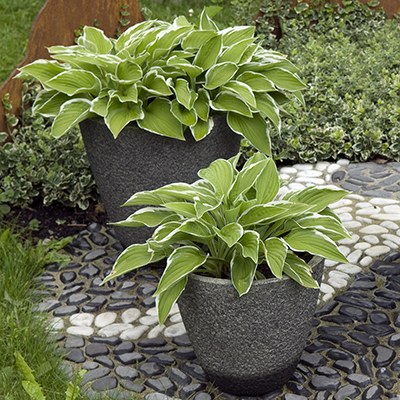How to Grow Hostas

Last updated January 23, 2024
Perennial hosta are foliage favorites in a variety of garden settings. On their own, they bring bold shapes and cool tones to shady spaces. With fellow shade favorites like coral bells and ferns, they create sophisticated plantscapes of color and texture. In spring, they're the backdrop for bulbs like tulips and daffodils. The rest of the season, count on hosta to edge your flower beds.
Hostas are popular for at least three reasons: they're easy to grow, they thrive in part to full shade, and they're fun to collect. In this guide, learn more about growing hostas in your garden.
Table of Contents
About Hostas
Best Sites for Hostas
How to Plant Hostas
How to Care for Hostas
How to Divide Hostas
About Hostas

Most gardeners grow hostas for the spectacular foliage, but the plants also send up flower stalks in summer. The blooms are white, pink, lavender, pale blue or purple. Foliage colors range from shamrock green to chartreuse to teal blue. In your garden bed, plant contrasting blooms in pink, red, orange and yellow for maximum impact from spring through fall.
The Home Depot carries a wide variety of this popular perennial, grown by suppliers throughout the country. Chances are, the hostas you buy in the Garden Center are locally grown.
Best-selling varieties to look for are:
- 'Golden Tiara'
- 'Green Royal'
- 'Guacamole'
- 'Minuteman'
- 'Patriot'
- 'Paul's Glory'
- 'Rainforest Sunrise'
- 'Sum and Substance'
Hostas are the top-selling perennial for shade, and many gardeners will confirm once you start growing them, you'll want to grow more. If you've got a shady space to fill, use hostas like a groundcover and pack the garden with plants. Hostas also make excellent container plants.
Best Sites for Hostas

Hostas are shade-tolerant, but thrive best in areas with dappled sunlight. Just as important as sunlight is to have well-draining soil. Hostas do not like to have wet feet. Amending soil with organic compost when planting, and again each spring will help nourish the plants and improve the soil texture.
Tips for siting hostas in your garden:
- Choose a site with morning sun, offering enough light for the foliage and flowers to develop. Afternoon sun is likely too harsh, and will result in yellowed leaves and possibly loss of the plant.
- Most hostas are hardy throughout Zones 3 to 9, needing just 30 days of cold temps for their dormant period. When the ground warms up, hardy hostas are back at it again, unfurling their tender shoots.
- Plant hostas from early spring to late summer, up to 30 days before the first frost in fall.
- Be sure to give the plants room to spread — leave 1 to 3 feet in between average-sized hostas. Smaller varieties like 'Mouse Ears' can be planted closer.
How to Plant Hostas

When you have your site ready, follow these steps to plant hostas.
- Dig a hole, as deep as the plant pot and double the width of the plant.
- Mix into the native soil a layer of organic compost. You can also add a slow-release fertilizer to the planting hole.
- Carefully remove the plant from its container. If the plant is root-bound, gently untangle and shake out the roots.
- Place the plant in the hole so that the top of the root ball is level with the soil surface.
- Carefully fill in around the root ball and firm the soil.
- Water thoroughly and frequently, until established. In hot weather, be sure to give newly-planted hostas an extra drink of water.
How to Care for Hostas

Once they're established in your garden, hostas are low-maintenance plants. Routine fertilizing, pruning damaged leaves, and dividing, should take care of their needs.
If there’s one strike against hosta, it’s that deer love their tender leaves. If deer are a problem in your area, consider planting hosta close to your home or behind a tall fence.
In addition to deer, hosta are popular with rabbits, voles, slugs and snails. Reduce slug appeal with a coarse bark mulch and leave a mulch-free zone about 6 inches around each plant. Avoid watering in the evening so that leaves will be dry at night. Look for more deer repellents.
How to Divide Hostas

Hostas are popular pass-along plants. Gardeners split hosta crowns to make more plants in spring and fall. In the spring, divide once the hosta eyes are popping up and before the leaves unfurl. In fall, divide when the weather turns cool. Water the day before you divide your plants, or better yet, divide after a plentiful rainfall.
Steps for dividing hostas:
- Set a tarp on the ground nearby to help move and cleanup divided plants.
- Use a garden spade to try to slice as few eyes and retain as many roots as you can.
- When the plant is out of the ground, use a garden knife like a hori-hori to cut the plant apart. (A serrated bread knife reserved for garden use works well, too.)
- Before replanting, add organic compost to the hole. Plant at the same depth as before and be sure to soak the plant with water.
Keep hostas watered throughout the hot months and apply a slow-release organic fertilizer in spring. An annual application of compost over the bed each fall nourishes the plants through the winter.
Perennial hostas are easy-care, shade-tolerant favorites for your garden. When you're ready to grow hostas and need the right plants, tools and garden soil, The Home Depot delivers online orders when and where you need them.




























